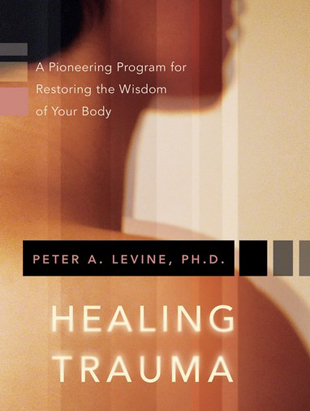Peter A. Levine holds doctorates in medical biophysics and psychology. Based on his decades of work in the field of stress and trauma, he developed the Somatic Experiencing® approach to healing trauma. Dr. Levine was a stress consultant for NASA on the development of the first space shuttle and was a member of the Institute of World Affairs Task Force of Psychologists for Social Responsibility for response to large-scale disaster and ethno-political warfare. His bestselling book Waking the Tiger: Healing Trauma has been translated into twenty-two languages. Dr. Levine also received the Lifetime Achievement award from the United States Association for Body Psychotherapy.
In Healing Trauma, Dr. Levine defines trauma, lists its causes and symptoms, and provides helpful tips for preventing its effects at the scene of an accident and for helping a child who has been traumatized. Levine’s focus in this book is his twelve-phase approach to healing. Levine divides the twelve phases for healing the effects of trauma on the body into the following four groups:
- Preparatory Phases (phases 1 to 3)
- Tracking Skills (phases 4 to 6)
- Discharging Activation (phases 7 to 9)
- Completion: Returning to Equilibrium (phases 10 to 12)
The phases are as follows:
1. Safety and Containment Exercises: Finding Your Body Boundaries
2. Grounding and Centering
3. Building Resources
4. From “Felt Sense” to Tracking Specific Sensations
5. Tracking Activation: Sensations, Images, Thoughts, and Emotions
6. Pendulation: Tracking Your Rhythms of Expansion and Constriction
7. Fight Response: Natural Aggression versus Violence
8. Flight Response: Natural Escape versus Anxiety
9. Strength and Resilience versus Collapse and Defeat
10. Uncoupling Fear from the Immobility Response
11. Orientation: Moving from Internal to External Environment and Social Engagement
12. Settling and Integrating
Dr. Levine’s program for healing the body is based on the idea that “body sensations, rather than intense emotion, are the key to healing trauma.” Levine asserts that “because trauma happens primarily on an instinctive level, the memories we have of overwhelming events are stored as fragmentary experiences in our bodies, not in the rational parts of the brain.” For Levine and his readers, this is a cause for hope:
There’s some really good news here. My research led me to believe that people do, in fact, possess the same built-in ability to shake off threat that animals do. And in my clinical practice, I have found this to be the case. I found that, if given appropriate guidance, human beings can and do shake off the effects of overwhelming events and return to their lives using exactly the same procedures that animals use.
Accordingly, the program Levine offers is one of simple and accessible activities to heal by releasing the effects of trauma from the body. The activities, which are also available via audio (digital access), can be completed in a week and a half to two weeks.
